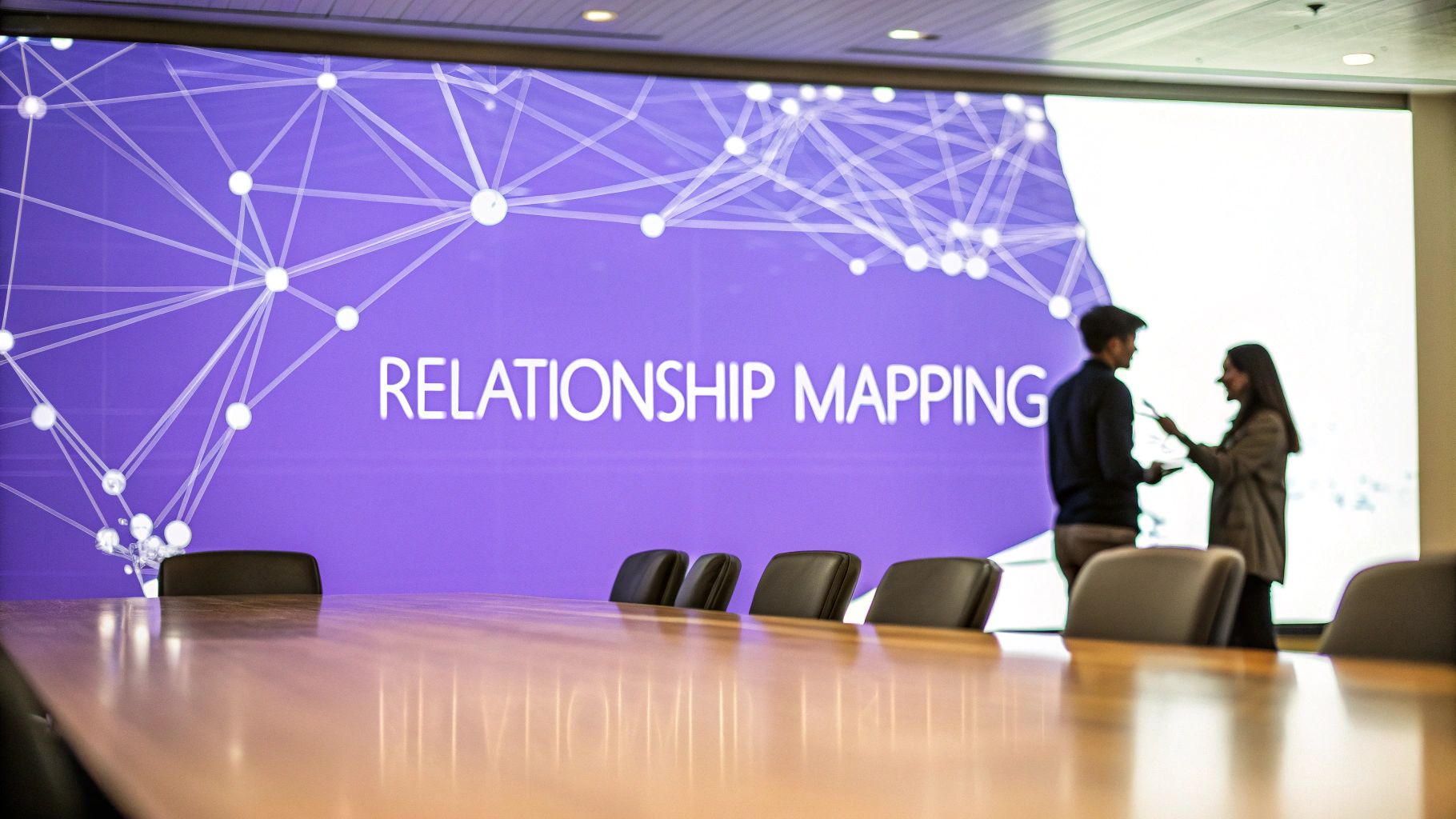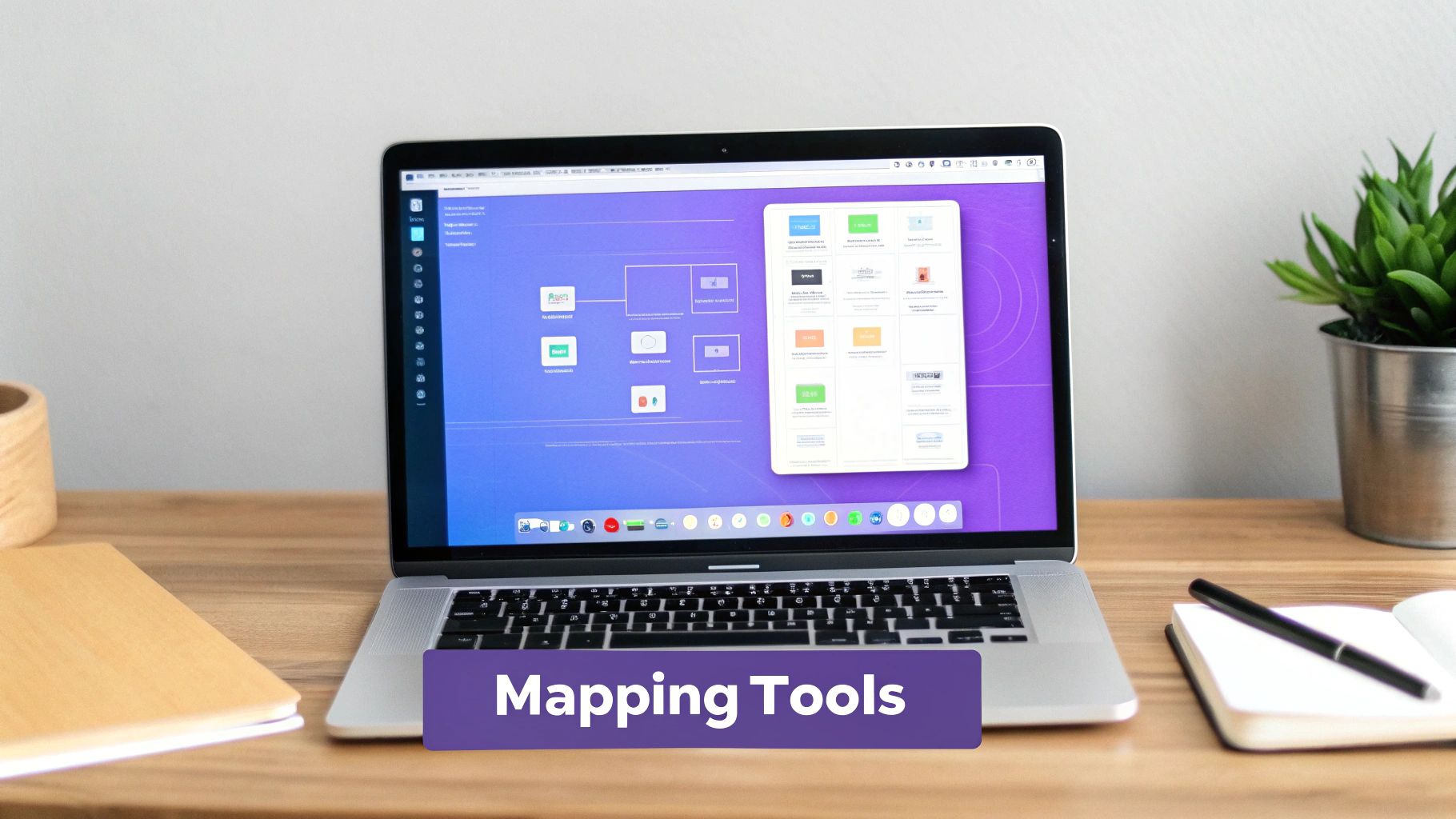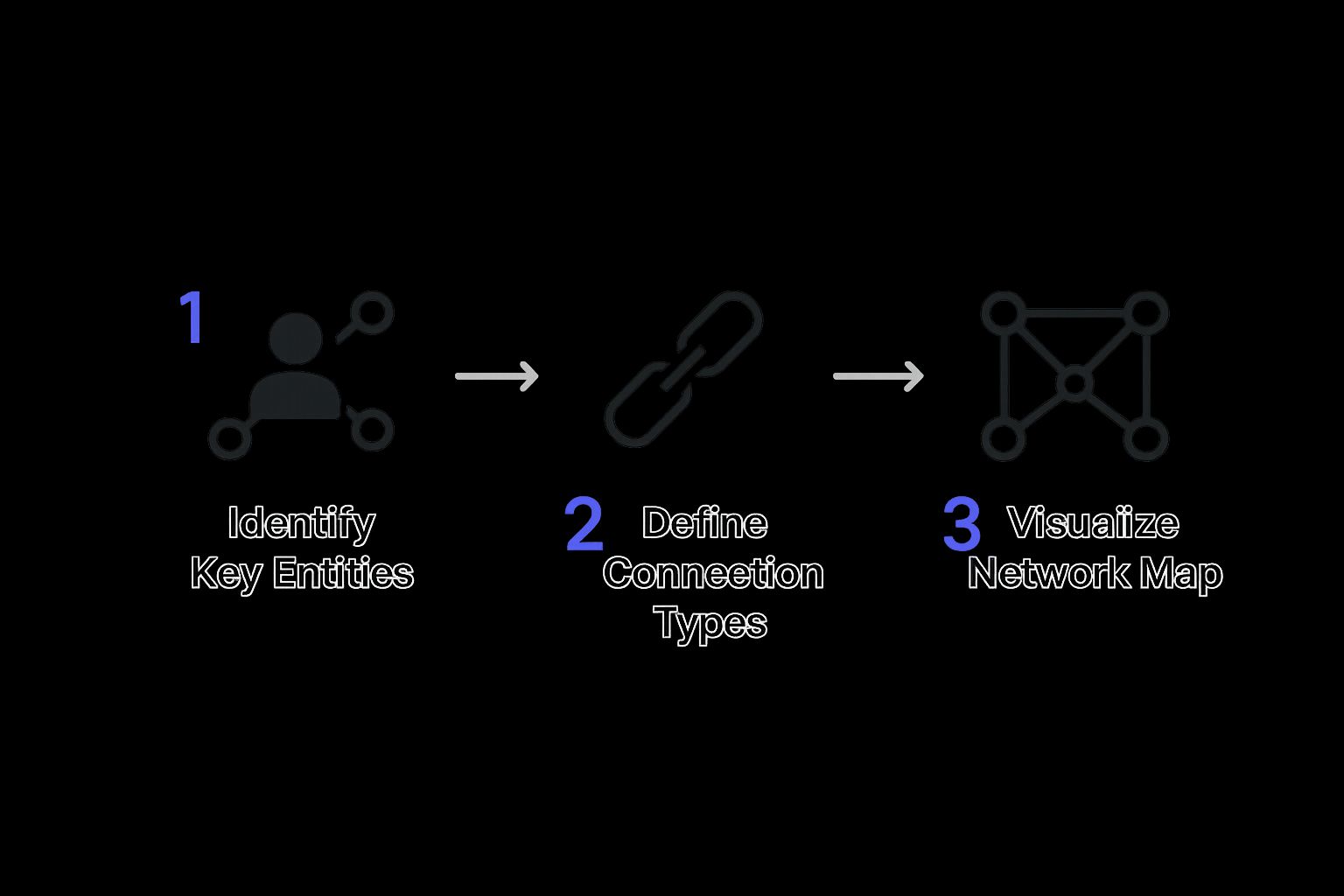
At its heart, relationship mapping is the process of visualizing all the key people within a client’s company and, crucially, how they relate to each other. It’s less about a formal, stiff org chart and more like a detailed playbook for navigating the human side of a business. This visual guide shows you who really calls the shots, who your internal cheerleaders are, and where you might run into trouble.
Trying to manage a major account without a relationship map is like trying to assemble complex furniture with no instructions. You might get a few pieces to fit, but you’re mostly guessing, and the final result will be wobbly at best. You probably know your main point of contact, but who do they listen to? Who holds the purse strings? Who is the unofficial expert everyone turns to for advice?
Getting the answers to these questions is what relationship mapping is all about. This isn't just about drawing boxes and lines; it's about creating a living, breathing diagram of the human network you need to understand and engage with.
A great relationship map takes the guesswork out of account management. It turns abstract office politics and social dynamics into a clear, actionable guide, showing you the hidden pathways to the people who can make or break your success.
The official org chart is a starting point, but it only tells you half the story—the formal chain of command. It completely misses the informal networks where real influence and decisions happen. This is where relationship mapping truly shines. It captures both the formal and informal, helping you see the whole picture.
This means you can pinpoint individuals who are critical to your success, even if they don't have a fancy title. You'll start to identify:
Once you can see these roles and how they all connect, your entire strategy shifts. You stop being reactive and start being proactive. You can spot potential problems before they happen, give your champions the support they need to succeed, and make sure you're talking to the right people with the right message.

Sure, understanding your customer’s internal network is interesting, but the real magic of relationship mapping happens when you see its direct impact on your bottom line. It's the difference between simply managing an account and strategically growing it for the long haul. This isn't just theory; it's about translating human connection into real business results.
Think about it: a clear map of who's who immediately shortens your sales cycles. Instead of spending months trying to figure out an organization's power structure, your team can pinpoint the real decision-makers and internal advocates right away. This speeds up deals and cuts down on wasted time.
This same mapping principle isn't just for customers. It’s also a cornerstone of good vendor relationship management best practices, helping you navigate and strengthen your own supply chain.
Relationship mapping is also your best defense against unexpected account risks. Picture this: your main contact, the person who championed your product from the beginning, suddenly leaves their job. Without a map, that’s a five-alarm fire. Your entire account is at risk.
But with a map, you’ve already identified and built a connection with other key players and influencers. You can see this risk coming and proactively strengthen those other relationships, keeping the account stable and secure.
A relationship map is your early warning system for account health. It helps you see personnel changes not as a crisis, but as a manageable event that you are fully prepared for.
This proactive approach flips the script, moving your team from defense to offense. The very same map that protects your existing revenue also shines a spotlight on new opportunities. By visualizing the entire organization, you can easily spot pathways into other departments or business units.
This clarity can completely change your account strategy. Your map might show that your champion has a great relationship with a department head who could use another one of your services. Suddenly, a simple renewal discussion turns into a strategic expansion—all because you took the time to map the human network.

The theory behind relationship mapping is one thing, but seeing how the best teams actually use it day-to-day is where its real power shines. For them, it’s not some abstract exercise; it’s a core part of their playbook for handling complex accounts and landing major deals. They’re turning static customer lists into a living, breathing strategic advantage.
For example, top-tier strategic account managers live and die by their relationship maps. They meticulously chart out the political landscape of a client’s organization, identifying every key player—from the most enthusiastic end-user to the notoriously skeptical budget holder. This deep insight helps them weave their solutions so deeply into a client’s operations that renewals become a foregone conclusion.
This is why we're seeing such a massive investment in supporting software. The global market for Customer Relationship Management (CRM) systems, the platforms where this data lives, is on track to hit $123.24 billion by 2030. This figure alone shows just how crucial these data-driven tools are for managing vital connections at scale. You can read more about the CRM market's projected growth on mordorintelligence.com.
Enterprise sales teams face a particularly tough challenge: massive buying committees with confusing, often unwritten, reporting lines. A single "no" from a stakeholder you didn't even know existed can completely torpedo a deal that’s been in the works for a year. This is precisely where relationship mapping acts as a deal-saving insurance policy.
Smart reps use these maps to build multi-threaded relationships, intentionally creating connections across various departments and levels of seniority. This strategy builds incredible resilience. If their main champion suddenly leaves the company or an executive sponsor gets moved to another project, the deal doesn't just fall apart. They've built a whole network of other supporters ready to keep the momentum going.
By visually mapping out every stakeholder, sales teams can turn a confusing web of people into a clear roadmap for closing the deal. They can see objections coming, build consensus methodically, and eliminate any single point of failure.
The map’s job isn't done once the ink is dry on the contract. For customer success teams, it’s the essential tool for kicking off a smooth and effective onboarding process. They inherit this map and put it to work immediately.
They use it to:
This kind of proactive engagement really sets the stage for the entire relationship. By understanding who's who right from the start, customer success managers help new clients see value fast, which is the foundation for long-term loyalty and future growth.
Building your first relationship map doesn't have to be some monumental task. Think of it less like a chore and more like sketching out a game plan for your most important accounts. It’s all about taking those random bits of information you have—names, titles, meeting notes—and turning them into a visual guide you can actually use.
The process kicks off with one simple goal: identify everyone who matters. It's time to look past your day-to-day contact and start listing all the players. This includes the executive who signs off on the budget, the end-users who live in your product every day, and everyone in between. Just get their names, titles, and roles down.
With your list of names, the real work begins. You need to understand where each person fits into the puzzle. Every company has its own internal politics, and a simple framework can help you see it clearly. Start by slotting each contact into one of these categories:
Once you’ve categorized your contacts, it's time for a little detective work. Scour LinkedIn to map out reporting structures. Dive into your CRM notes from past conversations. Most importantly, talk to your champion. Ask open-ended questions like, “Who else on the team will this decision affect?” or "Is there anyone else we should loop in?" to uncover those hidden stakeholders you didn't know existed.
This simple, three-stage approach helps you visualize your network.

This process is what turns a simple list of names into a strategic asset. You’re no longer just knowing people; you’re starting to understand their influence and how they connect.
Now for the fun part: making it visual. You can go low-tech with a whiteboard or use a dedicated relationship mapping tool. Start drawing lines to connect individuals. Solid lines can show direct reporting relationships, while dotted lines might represent informal influence. You can even use different colors—maybe green for your champions and red for blockers or strained relationships.
A relationship map is more than just a diagram; it's a dynamic asset. The goal is to analyze the connections to find the path of least resistance for renewals, identify upsell opportunities, and mitigate risks before they escalate.
With your map laid out, you can finally step back and see the big picture. Where are your relationships solid? More importantly, where are the gaps? This analysis is what transforms your drawing from a simple chart into a powerful tool for navigating your customer accounts and growing them strategically.

Think of a relationship map less like a framed photograph and more like a living garden. You can’t just plant the seeds and walk away; it needs constant attention to thrive. If you let it go, it quickly gets overgrown with outdated information and loses all its strategic value.
The secret to keeping your map useful isn't to schedule more meetings or add another task to your plate. It's about weaving the updates directly into the work you’re already doing. When map maintenance becomes a natural part of your daily and weekly rhythm, it stops feeling like a chore and turns into a powerful, proactive habit.
So, how do you make this happen? Start by building a regular review cadence into your key account meetings. Your quarterly business reviews (QBRs) and annual planning sessions are the perfect time to pull up the map and ask some tough questions:
A relationship map is only as powerful as the information it contains. Integrating it directly into your CRM creates a single source of truth, ensuring the entire team is working from the same playbook and contributing to a unified strategy.
This brings us to the most critical piece of the puzzle: collaborative ownership. A truly effective relationship mapping culture isn't one where a single person is the "map owner." It’s one where everyone on the team feels a sense of responsibility for keeping it accurate.
When a sales rep hears about a management change or a CSM discovers a new internal influencer, they should feel empowered to add that intel to the map right away. This shared effort transforms your map from a static document into a dynamic, strategic asset that helps you see around corners, find new opportunities, and build much stronger customer partnerships.
Let’s be honest: building and maintaining a relationship map by hand can be a real slog. But just as GPS made paper road maps obsolete, artificial intelligence is doing the same for static org charts. AI is turning relationship mapping into a dynamic, intelligent engine that doesn't just show you a snapshot in time—it helps you predict what’s next.
Modern AI tools do the heavy lifting for you. They dig through your communication data—emails, calendar invites, CRM notes—to automatically identify who the key players are. More importantly, they figure out the strength and quality of those connections, saving your team countless hours of manual detective work.
This kind of automation is a huge reason why related markets are booming. Take the Partner Relationship Management market, for example. It's projected to grow from $91.30 billion in 2024 to an incredible $424.82 billion by 2034. That explosive growth is largely thanks to AI's power to analyze and strengthen business connections. You can dig into more of the numbers in the full Partner Relationship Management market report from Precedence Research.
Beyond just saving time, AI brings something truly powerful to the table: predictive relationship analytics. Imagine a system that doesn't just tell you who knows whom, but actually forecasts the health of your customer relationships. This is where strategic account management is headed.
These advanced AI-driven systems can pinpoint critical insights you might otherwise miss. They can:
AI fundamentally changes relationship mapping from a reactive, historical record into a proactive, forward-looking strategy. It’s like having a crystal ball that helps you see around corners, anticipate customer needs, and jump on opportunities before your competition even knows they’re there.
By integrating AI, this deeply human strategy can finally scale across the entire enterprise. It ensures your understanding of a client’s world is always current, making it an essential tool for any business that wants to stay ahead.
As teams start to get serious about relationship mapping, a few questions always pop up. It’s totally normal. Getting these sorted out is key to making this more than just a one-off exercise and turning it into a powerful, consistent habit.
Honestly, the "best" tool really just depends on where you're at. You don’t need a complicated system to get started. I’ve seen teams begin with nothing more than a physical whiteboard and some sticky notes, and it works. Digital whiteboards like Miro are a great next step.
As you get more sophisticated, you'll find that most CRMs have some basic mapping functions built-in. But if you're managing complex enterprise accounts, dedicated platforms like Statisfy are in another league. They use AI to automatically build and analyze your maps, which can be a massive time-saver.
The official org chart tells you one story, but it’s rarely the whole story. The real power often lies in the informal networks—the people everyone listens to, regardless of their title. So, how do you find them? You have to listen more than you talk and ask smarter questions.
Here’s a simple but incredibly effective question to ask your champion: "Besides your boss, whose opinion is most respected on this topic?" The answer almost always points you directly to the unofficial influencers who can truly make or break your success.
Think of your relationship maps as living, breathing documents, not static files you create once and forget. They're only useful if they're current.
For your most important, strategic accounts, you should be reviewing and updating these maps every quarter, probably as part of your regular business reviews. For smaller or less complex accounts, a check-in every six months is a reasonable goal to keep things fresh.
Ready to stop guessing and start building a real strategy? Statisfy’s AI-powered platform automates the entire relationship mapping process, turning your customer data into actionable insights that drive renewals and growth. Learn more at Statisfy.